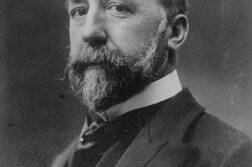ON JUNE 26, 2008, 1,000 ministers, mostly from evangelical congregations, met by conference call to discuss tactics for passing Proposition 8, a ballot initiative to ban same-sex marriage in California by amending the state constitution. The call was convened by Pastor Jim Garlow from the 2,500-member Skyline Church in San Diego County. The ministers on the call had a far reach: they lead congregations representing about one million people, and Garlow alone provides radio commentary to 629 stations each day. The strategy session, which included input from lawyers and political consultants, was one of many efforts in a broad-based organizing campaign by the Christian Right to galvanize support for Proposition 8.
Proposition 8 passed in the November 2008 election by four points, with 52 percent of voters supporting it and 48 percent opposing it. The religious Right was successful in its multi-pronged assault on same-sex marriage in a state that has national significance in the marriage equality movement. Simply put, they out-organized the No on 8 campaign.
An analysis of how the pro-8 forces succeeded reveals a campaign of misinformation and unlikely alliances, one that took years of planning dating back to at least the mid-1990’s. It also reveals a shrewd, media-savvy, and well-funded grassroots organization that understood California’s complex geographic and political landscape. The Yes on 8 campaign effectively reached California’s diverse racial and ethnic communities with materials translated into at least fourteen different languages, including Spanish, Hmong, Vietnamese, Chinese, Filipino, Samoan, Punjabi, Farsi, Russian, and Polish. In contrast, the No on 8 campaign offered materials on their website in only four languages other than English.
During the conference call on the weekend before the election, Jim Garlow told the ministers that his goal was to fill Qualcomm Stadium in San Diego and other amphitheaters with people praying for a ban on gay marriage. To this end, they organized a forty-day fasting period leading up to election day, along with 100 days of prayer. “We are working with all the churches who are willing to work with us,” declared Frank Schubert, the campaign manager for Yes on 8. “It’s woven together to form what we hope will be the largest grass-roots campaign in California history.”
The Yes on 8 campaign set out to test the limits on how far the initiative process could further a conservative cause. Campaign organizers built a well-funded operation that rivaled any major electoral campaign in scope and complexity. The campaign assembled a broad network of support and funding from prominent Christian Right organizations, including Focus on the Family, Concerned Women for America, and the Family Research Council. The campaign raised more than $40 million from conservative supporters across the country. Much of the funding came from prominent donors like the Utah-based Church of Jesus Christ of Latter-Day Saints (LDS) and the Knights of Columbus, a conservative Catholic group. Yes on 8 also received donations from Elsa Broekhuizen, the widow of Michigan-based Christian Right supporter Edgard Prince and the mother of Erik Prince, founder of Blackwater, the controversial private paramilitary firm.
The initiative’s third largest private donor was Howard F. Ahmanson, Jr., the reclusive heir to the Home Savings of America banking fortune and a trustee of the Ahmanson Foundation. Ahmanson donated $900,000 to the pro-8 campaign. In a 1985 interview with the Orange County Register,  Ahmanson summarized his political agenda: “My goal is the total integration of biblical law into our lives” (quoted by Max Blumenthal in TheDailyBeast.com, 11/3/08). Ahmanson has been behind campaigns to teach “intelligent design” in public school classrooms and to roll back affirmative action in California. He has been a supporter of anti-gay issues for many years. Ahmanson’s most controversial philanthropy relates to his funding of the religious empire of Rousas John Rushdoony, an evangelical theologian who advocated placing the United States under the control of a Christian theocracy which includes death by stoning for practicing homosexuals.
Ahmanson summarized his political agenda: “My goal is the total integration of biblical law into our lives” (quoted by Max Blumenthal in TheDailyBeast.com, 11/3/08). Ahmanson has been behind campaigns to teach “intelligent design” in public school classrooms and to roll back affirmative action in California. He has been a supporter of anti-gay issues for many years. Ahmanson’s most controversial philanthropy relates to his funding of the religious empire of Rousas John Rushdoony, an evangelical theologian who advocated placing the United States under the control of a Christian theocracy which includes death by stoning for practicing homosexuals.
In an internal memo dating back to 1997, the LDS proposed a coalition with the Catholic Church in order to stem what they saw as the rising tide of same-sex marriage in Hawaii and California. In the memo, a high-ranking Mormon leader discussed approaches for challenging gay marriage and noted that anti-gay marriage legislation would not be a successful pursuit. The memo argues that a referendum, while expensive, would be a better strategy. It advocates an alliance with the Catholic Church: “The Church should be in a coalition and not out front by itself. The public image of the Catholic Church is higher than our Church. … If we get into this, they are the ones with which to join.” The memo contends that in order to win the battle against gay marriage, “there may have to be certain legal rights recognized for unmarried people such as hospital visitation so that opponents in the legislature come away with something.” The Right was willing to concede some rights for gays in an effort to defeat same-sex marriage.
The fact that the coalition to define marriage in California as the union between “one man and one woman” was spearheaded by a church (the LDS) whose founder had 33 wives did not seem to deter their drive to deny gays the right to marry. The coalition, which framed their support for Prop 8 as a fight to protect children, was held together by the Catholic archbishop of San Francisco, who once excused a pedophile priest’s molestation of children as mere “horseplay.”
THE YES ON 8 COALITION based its hopes on a campaign of staggering misinformation. Multiple advertisements told voters that without Prop 8 their churches would be forced to perform same-sex unions or face the loss of their tax-exempt status. Voters learned that schools would teach children to practice homosexuality. And they were repeatedly reminded Barack Obama did not favor gay marriage, even though he expressly opposed Prop 8. Obama’s statement against gay marriage was circulated in a flier targeting African-American households. The campaign also used Obama’s voice in a statewide robo-call. These tactics were especially effective in mobilizing communities of color in favor of the proposition.
Aware that public opinion had shifted toward support of marriage equality since Prop 22 in 2000, when 61 percent voted to ban same-sex marriage in California, the campaign did not put out a message of overt hatred against GLBT people. Indeed they made a point of claiming that they were not taking rights away from anyone: “Gay couples in domestic partnerships have and will continue to have the same legal rights as married spouses. We’re not here to stop anyone from expressing their commitment or responsibility to another. We’re simply here to protect the definition of marriage to what the majority of California voters (and all of history) have decided it should be—a union between a man and a woman.” This strategy appealed to a moderate electoral segment that thought of itself as compassionate toward gays, giving them permission to take a cherished right away while “upholding the sanctity of traditional marriage.”
The campaign’s message centered on children and the harm that same-sex marriage would wreak. The campaign insisted on the falsehood that if Proposition 8 did not pass, children would be forced to learn about gay marriage in schools. “If the same-sex marriage ruling is not overturned, teachers will be required to teach young children that there is no difference between gay marriage and traditional marriage.” This was coupled with the message that no rights would be taken away from gays and lesbians if Proposition 8 passed.
One press release noted, “[San Francisco] Mayor Gavin Newsom made it perfectly clear for parents throughout the state that the target is not just marriage for gay activists, they have also set their sites [sic]on our schools.” Mainstream outlets like the Los Angeles Times and the San Francisco Chronicle countered these falsehoods, as did the No on 8 campaign, but with little impact. The Right’s big lies had taken root in churches across the state—notably in rural, mostly white, communities and in many communities of color.
The Yes on 8 campaign understood that to win in California required campaigning in both urban and rural areas of the state as well as doing outreach to youth. The campaign effectively used media technologies and far-reaching social networking sites such as Facebook, MySpace, and Twitter. A Facebook group promoting Proposition 8 has more than 60,000 members. The Yes on 8 website made it simple for anyone to copy a sidebar or graphic for display on other websites and social networks. Some gay bloggers were surprised and appalled to discover that the following symbol had found its way onto their sites:
In October, as the election drew near, the Yes on 8 campaign organized a bus tour from Sacramento to San Diego with rally stops in Chico, Oakland, Salinas, Fresno, Modesto, Bakersfield, Lancaster, Los Angeles, Montclair, Indio, El Centro, Camarillo, and Fullerton. With the exception of Oakland and Los Angeles, a majority of voters in these regions supported the proposition. Nearly every television station in San Diego covered the end of the bus tour, and along the way the campaign was successful in generating media stories in television, radio, and newspapers.
Organizing in churches was also a key strategy. The Yes on 8 campaign gave very specific instructions to churches on how to organize their congregations to support the initiative.* Throughout the summer, Yes on 8 had more than 100,000 volunteers knocking on doors in every zip code in the state, giving them an enormous grassroots advantage. Central to their base of support were Christian people whom they were able to organize through churches. According to the campaign, they visited 70 percent of all California households in person, and contacted another 15 percent by phone. If these numbers are to be believed, the campaign’s get-out-the-vote effort was equally impressive. The weekend before the vote, the campaign’s volunteers went door to door, speaking to supporters and directing them to the right precinct locations. On election day Yes on 8 had 100,000 people—five per precinct—checking voter rolls and contacting supporters who hadn’t shown up to vote.
In addition to these stories, the campaign had a well-developed strategy of buying media ads in a range of ethnic media outlets. Early on in their efforts, the Yes on 8 campaign purchased ad space in Chinese, African-American, Spanish, and Korean media. In addition to purchasing these ethnic media advertisements, the campaign held massive rallies for Christians in communities of color. They ran commercials on Latino TV and radio statewide with prominent Latino spokespeople and religious leaders voicing support for the proposition. They were notably successful in building alliances with African-American pastors who used their sermons to galvanize support for Prop 8. The Asian community also was reached with ads placed in Chinese, Vietnamese, Korean, and South Asian media markets.
For years, the California Christian Right apparatus, long hampered by nativism and racism, had been unable to make inroads into communities of color—which now comprise over fifty percent of the state’s population. With Prop 8 they finally succeeded in building a base of support in these communities. This outreach—as well as that in rural, mostly white communities—could be instrumental to the Christian Right as it seeks to advance its broader agenda. The greatest concern is its desire to promote a kind of Christian nationalism that seeks to use the law and the electoral process to eliminate the constitutional wall separating church and state in pursuit of a fundamentally antidemocratic and authoritarian—indeed a theocratic—agenda.
For the moment, one of their strategies is to focus on same-sex marriage and to enshrine discrimination in constitutional amendments. As in California, the Right was able to pass anti-gay amendments in Florida, Arizona, and Arkansas (where the issue was adoption by same-sex couples). But this focus is only one part of a broader agenda of “family values” that also includes abstinence-only sex education, stringent divorce laws, coercive marriage promotion policies directed toward women on welfare, and attacks on reproductive freedom.
The LGBT movement has focused on marriage equality as a stand-alone issue and in the Prop 8 debacle missed the opportunity to organize and build a broad coalition, particularly in communities of color, one that addresses the range of issues affecting families, including economic security, immigration status, incarceration, and health benefits for non-married family members.
But for all its success with Prop 8 in 2008, the Right’s victory in California may be short-lived. The youth vote is one reason to be hopeful. Sixty-one percent of voters younger than thirty opposed Prop 8, while the same percentage of those older than 65 supported it. Generational shifts are likely to benefit GLBT efforts in the years to come.
Our current legal and economic structures favor straight married couples over other kinds of families. Meanwhile, a thirty-year political assault on the social safety net has left households with more burdens and constraints and fewer resources. There is, however, potential to create new structures that make it easier for all kinds of families to provide one another with adequate material support. A progressive response can find ways to recognize and accommodate all family structures with our public policies in order to build more stable families and communities. A continuing effort to diversify and democratize partnership and household recognition may have more staying power and potential for success in the longer term.
The Right’s success with the passage of Proposition 8 should be a call to the LGBT movement to build alliances across issues and constituencies. The efforts toward same-sex marriage should be part of a larger effort to strengthen the stability and security of diverse households and families.
* Instructions included: “Purchase enough plain white envelopes to distribute to your congregation. Download the contribution form located under Resources for Churches, on the Resources page of www.protectmarriage.com. Make enough copies of the contribution form to distribute to your congregation. Pass out envelopes and contribution forms to your congregation. Each individual donation should be put into a separate white envelope by the donor. Donations of $24 or under do not require the donor to complete the contribution form. Donations of $25 or over do require the contribution form to be completed. The completed form should be put into the envelope along with the donation. We can accept cash ($99 or under only), checks or credit card contributions. Checks should be made payable to ProtectMarriage.com—Yes on 8. Collect all envelopes from donors, put them in a larger mailing envelope, put your church name and return address on the mailing envelopes and send it via regular US mail.”
Surina Khan is Vice President of Programs for the Women’s Foundation of California. She is a former research analyst with Political Research Associates and a member of the Editorial Board of the Public Eye.





